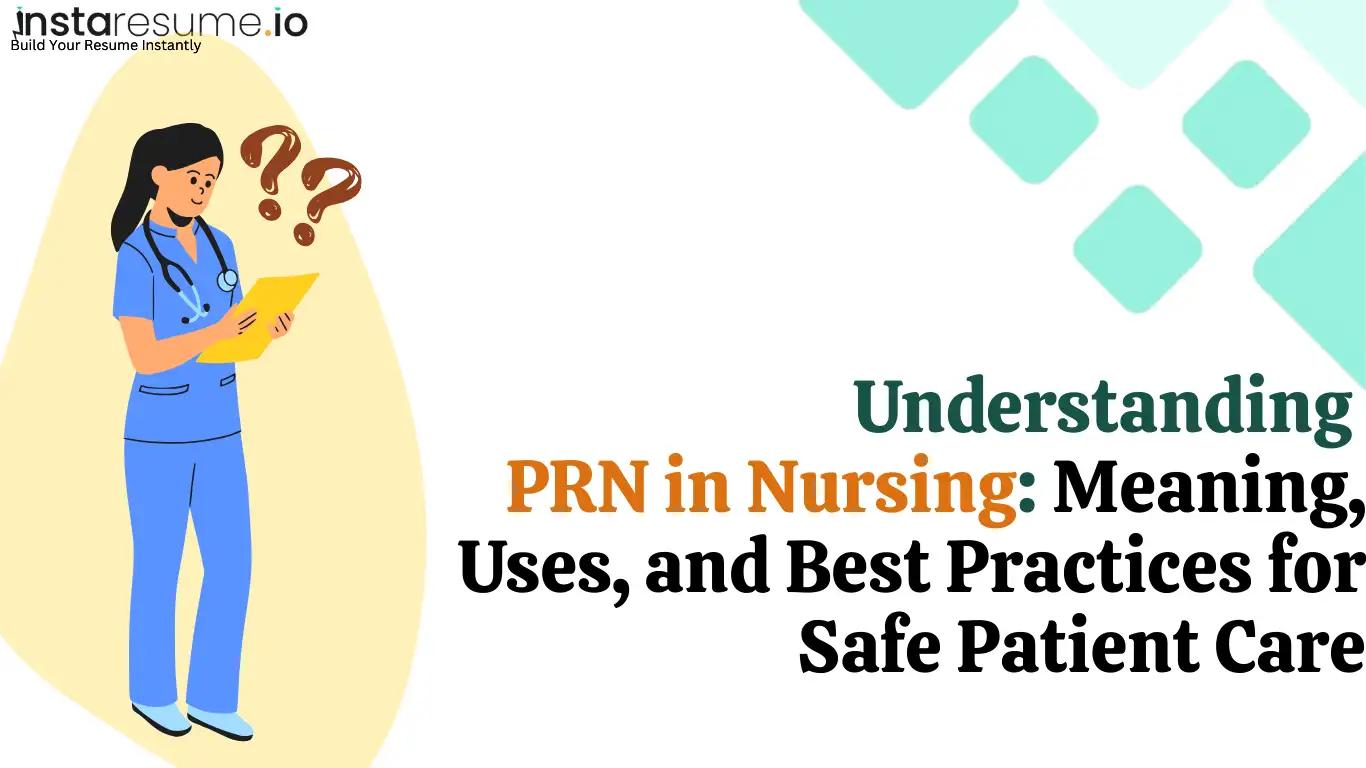Understanding PRN in Nursing: Meaning, Uses, and Best Practices for Safe Patient Care
Trust Score: 4.8
353 reviews

Table of Contents
Introduction
Healthcare is a field that never pauses, never takes a holiday, and never truly stops moving. With patient care needs constantly shifting, hospitals, clinics, and long-term care facilities must stay prepared for sudden staff shortages or spikes in demand. This is where PRN nursing jobs have become indispensable. The phrase PRN, short for the Latin term pro re nata—meaning “as needed”—captures the very essence of flexibility in nursing. Unlike full-time or part-time staff nurses who work fixed schedules, PRN nurses step in when their skills are most urgently required.
The role of a PRN nurse is more than just “filling in.” These professionals ensure continuity of care, uphold patient safety, and support overburdened staff during critical moments. For healthcare facilities, PRN nurses bring reliability, adaptability, and cost-effective staffing solutions. For nurses themselves, the benefits are equally powerful: competitive PRN nurse salary per hour, diverse work environments, and the freedom to create a schedule that suits their lifestyle.
Many nurses are drawn to this path because of its unique advantages. A PRN nurse schedule offers freedom from the rigidity of traditional shifts while still ensuring meaningful professional engagement. From working in emergency rooms during high patient inflows to assisting in nursing homes when permanent staff are unavailable, PRN nurses are trusted pillars of support in modern healthcare.
Beyond shift flexibility, PRN nursing opens doors to personal growth and career exploration. By working across different departments and facilities, nurses gain exposure to multiple specialties, expand their clinical expertise, and increase their long-term career value. It also provides opportunities for those balancing education, family, or secondary career goals.
In today’s healthcare environment—where demand for qualified nursing professionals continues to rise—PRN nursing jobs are not just an option, but a strategic career choice. Whether you’re wondering “how much does a PRN nurse make per hour” or exploring the difference between PRN nurse and staff nurse, this role is redefining how flexibility and patient care come together.
Simply put, PRN nursing blends independence, financial stability, and purpose—making it a win-win for both nurses and the patients they serve.
What does PRN mean in Nursing? Why it matters?
The term PRN in nursing comes from the Latin phrase pro re nata, which translates to “as needed.” In medical and nursing practice, PRN refers to medications, treatments, or nursing services that are not scheduled but provided when a patient’s condition requires it. For example, a doctor may prescribe PRN medication administration for pain relief, meaning the nurse gives the medicine only when the patient reports discomfort—not on a fixed timetable.
In nursing, the PRN role extends beyond medications. A PRN nurse works shifts as needed, filling staffing shortages, covering unexpected absences, or assisting during times of high patient volume. Unlike staff nurses with fixed schedules, PRN nurses have the flexibility to decide when and where they work, making them an essential part of the modern healthcare workforce.
Why PRN Nursing Matters in Healthcare
- Supports patient safety – By ensuring that staffing gaps are filled quickly, PRN nurses prevent care delays and maintain safe nurse-to-patient ratios.
- Enhances flexibility for nurses – A PRN nurse schedule allows professionals to balance work with family, education, or personal goals while still earning a competitive PRN nurse salary.
- Improves care quality – When PRN nurses document PRN orders correctly—whether for pain, anxiety, or sleep disturbances—they help physicians track patient responses and adjust treatment plans safely.
- Cost-effective staffing for facilities – Hospitals and clinics save on overtime costs while still accessing skilled professionals during peak demand.
In short, PRN in nursing means more than “as needed”—it symbolizes adaptability, continuity of care, and a bridge between patient safety and workforce flexibility. For both nurses and healthcare providers, PRN jobs in nursing matter because they bring balance, efficiency, and reliability to a system that can’t afford interruptions.
Examples of PRN Nursing in Action:
PRN nursing is not limited to one setting—it spans hospitals, clinics, long-term care facilities, and even home healthcare. Below are some practical examples that highlight how PRN nurses and PRN orders function in real-world patient care.
1. PRN Medication for Pain Management
A patient recovering from surgery may have a prescription for PRN pain medication, such as morphine or acetaminophen. Instead of administering doses on a fixed schedule, the nurse charts PRN medication only when the patient reports pain above a certain level. This prevents overmedication while ensuring comfort.
2. PRN Nursing Shifts in Emergency Departments
Hospitals often face sudden surges in patient volume, especially in emergency rooms. A PRN nurse schedule allows additional nurses to step in during these high-demand hours. By filling these staffing gaps, PRN nurses reduce wait times and maintain safe nurse-to-patient ratios.
3. PRN Orders for Anxiety or Sleep Disturbances
In mental health or long-term care facilities, doctors may write PRN orders for medications like sedatives or sleep aids. Nurses administer these treatments only when patients experience acute anxiety or insomnia, and they must document the intervention carefully to track effectiveness and safety.
4. Covering Staff Shortages in Nursing Homes
Nursing homes frequently rely on PRN nurses when full-time staff call out unexpectedly. In these cases, PRN nurses step in to provide continuity of care, ensuring residents still receive proper attention with activities of daily living, medication administration, and monitoring.
5. Seasonal Demand in Hospitals and Clinics
During flu season or public health emergencies, healthcare facilities experience higher patient admissions. Instead of overloading full-time staff with overtime, facilities bring in PRN nurses who can adapt quickly, assist multiple departments, and deliver safe, efficient care.
What qualification or licenses are required to become a PRN nurse?
To work as a PRN nurse, the qualifications and licensing requirements are essentially the same as those for any registered nurse (RN) or licensed practical nurse (LPN). However, because PRN nurses often move between facilities and settings, employers may seek additional flexibility and clinical experience.
1. Educational Requirements
 Licensed Practical Nurse (LPN/LVN): Requires completion of a state-approved practical nursing program (about 12–18 months).
Licensed Practical Nurse (LPN/LVN): Requires completion of a state-approved practical nursing program (about 12–18 months). Registered Nurse (RN): Requires either an Associate Degree in Nursing (ADN) or a Bachelor of Science in Nursing (BSN). Many facilities now prefer BSN-prepared nurses for PRN roles due to broader training.
Registered Nurse (RN): Requires either an Associate Degree in Nursing (ADN) or a Bachelor of Science in Nursing (BSN). Many facilities now prefer BSN-prepared nurses for PRN roles due to broader training. Advanced Practice Registered Nurse (APRN): For specialized PRN roles (nurse practitioner, nurse anesthetist, nurse midwife), a master’s or doctoral degree is required.
Advanced Practice Registered Nurse (APRN): For specialized PRN roles (nurse practitioner, nurse anesthetist, nurse midwife), a master’s or doctoral degree is required.
2. Licensure and Certification
 NCLEX Exam: After completing nursing education, candidates must pass the NCLEX-PN (for LPNs) or NCLEX-RN (for RNs) to obtain licensure.
NCLEX Exam: After completing nursing education, candidates must pass the NCLEX-PN (for LPNs) or NCLEX-RN (for RNs) to obtain licensure. State Nursing License: A valid, active nursing license in the state of practice is mandatory. Nurses using the Nurse Licensure Compact (NLC) can work across multiple states without needing separate licenses.
State Nursing License: A valid, active nursing license in the state of practice is mandatory. Nurses using the Nurse Licensure Compact (NLC) can work across multiple states without needing separate licenses. Basic Life Support (BLS) and Advanced Cardiac Life Support (ACLS): Most employers require current BLS certification, and many acute care facilities require ACLS certification for PRN nurses.
Basic Life Support (BLS) and Advanced Cardiac Life Support (ACLS): Most employers require current BLS certification, and many acute care facilities require ACLS certification for PRN nurses.
3. Experience Requirements
 Many employers prefer at least 1–2 years of clinical experience before hiring a PRN nurse, especially for high-demand areas like emergency care or critical care.
Many employers prefer at least 1–2 years of clinical experience before hiring a PRN nurse, especially for high-demand areas like emergency care or critical care. Some PRN nurse jobs accept new graduates but often pair them with preceptors until they gain independent confidence.
Some PRN nurse jobs accept new graduates but often pair them with preceptors until they gain independent confidence.
4. Additional Certifications (Optional but Valued)
 PALS (Pediatric Advanced Life Support) – for those working with children.
PALS (Pediatric Advanced Life Support) – for those working with children. TNCC (Trauma Nursing Core Course) – for emergency/trauma units.
TNCC (Trauma Nursing Core Course) – for emergency/trauma units. Specialty Certifications (oncology, geriatrics, psychiatric nursing, etc.) – increase competitiveness and pay.
Specialty Certifications (oncology, geriatrics, psychiatric nursing, etc.) – increase competitiveness and pay.
Why Qualifications Matter for PRN Nurses
Since PRN nurses must quickly adapt to different environments, employers value those with strong educational backgrounds, active certifications, and proven clinical competence. The right PRN nurse qualifications not only improve patient safety but also increase earning potential and shift availability.
What are the advantages and responsibility of a PRN nurse ?
Advantages and Responsibilities of a PRN Nurse
PRN nursing jobs are unique because they combine flexibility, independence, and professional growth. Understanding both the advantages and responsibilities helps aspiring nurses decide if this role aligns with their career goals.
Advantages of Being a PRN Nurse
- Flexible Work Schedule – A PRN nurse schedule allows nurses to choose shifts that fit their personal lifestyle, making it ideal for those balancing family, education, or secondary jobs.
- Competitive Pay – PRN nurses often earn higher PRN nurse salary per hour compared to full-time staff, especially in high-demand areas like emergency care, ICU, or specialty units.
- Diverse Experience – PRN nurses gain exposure to multiple departments, specialties, and healthcare facilities, enhancing their clinical skills and career opportunities.
- Work-Life Balance – Flexibility in scheduling reduces burnout and allows nurses to prioritize personal well-being alongside professional commitments.
- Career Advancement Opportunities – PRN roles provide access to continuing education, specialty certifications, and networking across healthcare settings.
- Valuable Contribution to Patient Care – PRN nurses fill critical staffing gaps, ensuring continuity of care and patient safety, especially during peak hours or emergencies.
Responsibilities of a PRN Nurse
- Administer PRN Medications Safely – Ensure proper PRN medication administration by following physician orders, monitoring patient responses, and documenting accurately.
- Patient Assessment – Evaluate patient conditions promptly to determine the need for PRN interventions or escalations.
- Documentation – Maintain clear, accurate, and timely PRN documentation in nursing for legal compliance and continuity of care.
- Adaptability – Quickly adjust to different units, patient populations, and hospital protocols.
- Collaboration with Healthcare Teams – Communicate effectively with doctors, staff nurses, and other healthcare professionals to provide seamless care.
- Follow Facility Policies – Adhere to PRN protocols, safety guidelines, and institutional standards while delivering care.
- Educate Patients and Families – Explain treatments, medications, and interventions to patients or caregivers when appropriate.
Summary
Being a PRN nurse is both rewarding and demanding. The role offers flexible schedules, higher pay, and diverse clinical experiences, but also requires adaptability, strong documentation skills, and accountability. By understanding both the advantages and responsibilities of a PRN nurse, healthcare professionals can make informed career decisions while positively impacting patient care.
How Does a PRN Nurse Role Differ from Full-Time or Part-Time Positions?
The PRN nurse role is distinct from traditional full-time and part-time nursing positions in several key ways. Understanding these differences helps aspiring nurses choose the career path that best aligns with their goals, lifestyle, and earning potential.
1. Work Schedule and Flexibility
 PRN Nursing: PRN nurses work as needed, choosing shifts based on their availability and the facility’s requirements. They often fill in for staff shortages, emergencies, or peak patient loads. This flexibility is ideal for nurses balancing education, family, or other commitments.
PRN Nursing: PRN nurses work as needed, choosing shifts based on their availability and the facility’s requirements. They often fill in for staff shortages, emergencies, or peak patient loads. This flexibility is ideal for nurses balancing education, family, or other commitments. Full-Time Nursing: Full-time nurses work fixed schedules, typically 36–40 hours per week, with consistent shifts and predictable responsibilities.
Full-Time Nursing: Full-time nurses work fixed schedules, typically 36–40 hours per week, with consistent shifts and predictable responsibilities. Part-Time Nursing: Part-time nurses have scheduled shifts but fewer hours than full-time staff. They may work two to four days a week but usually follow a pre-set schedule.
Part-Time Nursing: Part-time nurses have scheduled shifts but fewer hours than full-time staff. They may work two to four days a week but usually follow a pre-set schedule.
2. Compensation
 PRN Nursing: PRN nurses often earn a higher PRN nurse salary per hour or per shift because of the flexibility and critical nature of their work. Some facilities offer shift differentials for nights, weekends, or high-demand units.
PRN Nursing: PRN nurses often earn a higher PRN nurse salary per hour or per shift because of the flexibility and critical nature of their work. Some facilities offer shift differentials for nights, weekends, or high-demand units. Full-Time/Part-Time Nursing: Salaries are typically standardized based on hours worked, with benefits included (health insurance, retirement plans, paid leave). Hourly pay may be lower compared to PRN nurses, but benefits are more comprehensive.
Full-Time/Part-Time Nursing: Salaries are typically standardized based on hours worked, with benefits included (health insurance, retirement plans, paid leave). Hourly pay may be lower compared to PRN nurses, but benefits are more comprehensive.
3. Benefits and Job Security
 PRN Nursing: Most PRN nurses do not receive full employee benefits, such as paid vacation or health insurance. However, the trade-off is flexibility and the ability to work in multiple healthcare settings.
PRN Nursing: Most PRN nurses do not receive full employee benefits, such as paid vacation or health insurance. However, the trade-off is flexibility and the ability to work in multiple healthcare settings. Full-Time Nursing: Full-time nurses enjoy full benefits, job security, and access to professional development programs.
Full-Time Nursing: Full-time nurses enjoy full benefits, job security, and access to professional development programs. Part-Time Nursing: Part-time nurses may receive limited benefits, depending on the employer, and usually have less job security than full-time staff.
Part-Time Nursing: Part-time nurses may receive limited benefits, depending on the employer, and usually have less job security than full-time staff.
4. Variety of Experience
 PRN Nursing: PRN nurses gain exposure to diverse units, patient populations, and clinical environments. This makes PRN nursing jobs ideal for career growth, cross-training, and exploring specialties.
PRN Nursing: PRN nurses gain exposure to diverse units, patient populations, and clinical environments. This makes PRN nursing jobs ideal for career growth, cross-training, and exploring specialties. Full-Time/Part-Time Nursing: Full-time and part-time nurses usually work in a specific unit or department, which can provide consistency but may limit exposure to other areas of nursing practice.
Full-Time/Part-Time Nursing: Full-time and part-time nurses usually work in a specific unit or department, which can provide consistency but may limit exposure to other areas of nursing practice.
5. Responsibilities
 PRN Nursing: PRN nurses must quickly adapt to new environments, follow PRN protocols, and maintain accurate PRN documentation in nursing. They may work independently with limited supervision.
PRN Nursing: PRN nurses must quickly adapt to new environments, follow PRN protocols, and maintain accurate PRN documentation in nursing. They may work independently with limited supervision. Full-Time/Part-Time Nursing: Responsibilities are more predictable and consistent, with clearly defined workflows and unit-specific protocols.
Full-Time/Part-Time Nursing: Responsibilities are more predictable and consistent, with clearly defined workflows and unit-specific protocols.
How PRN Nursing Experience Contributes to Career Growth and Professional Development
Working as a PRN nurse offers unique opportunities for professional growth that are not always available in full-time or part-time positions. The flexibility and diversity of PRN nursing jobs allow nurses to enhance skills, broaden clinical knowledge, and increase their marketability in the healthcare field.
1. Exposure to Diverse Clinical Environments
PRN nurses often rotate across multiple units, hospitals, or specialty departments. This variety enables them to gain experience in areas such as:
 Emergency care
Emergency care Critical care/ICU
Critical care/ICU Pediatrics
Pediatrics Geriatrics
Geriatrics Mental health and long-term care
Mental health and long-term care
By working in different clinical environments, PRN nurses acquire a broad skill set that makes them more versatile and valuable to employers.
2. Skill Enhancement and Continuing Education
PRN nurses frequently encounter unique patient cases and medical scenarios that require quick thinking and adaptability. This real-world experience helps them:
 Develop advanced clinical skills
Develop advanced clinical skills Improve critical thinking and decision-making
Improve critical thinking and decision-making Gain familiarity with PRN medication administration and PRN protocols
Gain familiarity with PRN medication administration and PRN protocols
Many PRN nurses also take advantage of continuing education opportunities and specialty certifications, which further enhance their professional development and open doors for higher-paying or leadership roles.
3. Networking and Career Opportunities
Since PRN nurses often work in multiple healthcare facilities, they can expand their professional network significantly. Connections with doctors, senior nurses, and administrators can lead to:
 Full-time or part-time job offers
Full-time or part-time job offers Specialty nursing roles
Specialty nursing roles Leadership or educator positions
Leadership or educator positions
This networking advantage allows PRN nurses to explore career pathways that may not have been available within a single facility.
4. Increased Marketability and Resume Strength
Experience as a PRN nurse demonstrates adaptability, reliability, and clinical competence—qualities that are highly valued by employers. Including PRN nursing experience on a resume can make a candidate stand out for:
 Travel nursing positions
Travel nursing positions Specialized nursing roles (e.g., ICU, ER)
Specialized nursing roles (e.g., ICU, ER) Advanced practice positions (e.g., Nurse Practitioner)
Advanced practice positions (e.g., Nurse Practitioner)
Summary
Overall, PRN nursing experience contributes to career growth by providing diverse exposure, enhancing clinical skills, expanding professional networks, and increasing marketability. Nurses who take on PRN roles not only gain flexibility and competitive pay but also position themselves for long-term professional development and leadership opportunities in healthcare.
Do PRN Nurses Earn Higher Salaries Compared to Full-Time or Part-Time Nurses?
One of the biggest advantages of PRN nursing jobs is the potential for higher hourly pay. Unlike full-time or part-time nurses, PRN nurses are often compensated at a premium for their flexibility and ability to fill critical staffing gaps.
1. Competitive Hourly Rates
PRN nurses typically earn higher pay per hour than their full-time counterparts. The exact salary depends on factors such as:
 Facility type (hospital, clinic, nursing home)
Facility type (hospital, clinic, nursing home) Geographic location
Geographic location Specialty area (ER, ICU, pediatrics)
Specialty area (ER, ICU, pediatrics) Level of experience and certifications
Level of experience and certifications
For example, an experienced PRN nurse in an ICU or emergency department can earn significantly more per hour than a staff nurse working fixed shifts.
2. Shift Differentials
Many healthcare facilities offer shift differentials for PRN nurses working nights, weekends, or holidays. This means nurses can earn extra compensation on top of their already competitive hourly rates, making PRN nurse salary per shift very attractive.
3. Overtime and Extra Shifts
Since PRN nurses are often called in for high-demand periods, they have the opportunity to work additional shifts without committing to a full-time schedule. This flexibility allows nurses to increase their overall income while maintaining control over their work-life balance.
4. Benefits and Trade-Offs
It’s important to note that while PRN nurses often earn higher salaries, they may not receive full-time benefits like health insurance, paid vacation, or retirement plans. However, many nurses view this trade-off as worthwhile for the combination of flexibility, autonomy, and earning potential.
Summary
In short, PRN nurses can earn higher salaries than full-time or part-time nurses due to premium hourly rates, shift differentials, and opportunities for extra shifts. For nurses seeking competitive pay and flexible schedules, PRN nursing offers a unique balance of income and independence. Additionally, nurse managers often rely on experienced PRN nurses to fill critical staffing gaps and maintain quality patient care during high-demand periods.
How can PRN nurses maintain their clinical skills while working irregular hours ?
One challenge many PRN nurses face is staying sharp and maintaining clinical competence while working irregular shifts. Because PRN roles are flexible and often intermittent, it’s essential for nurses to proactively manage their skill development and knowledge base.
1. Continuing Education and Certifications
 Enroll in continuing education courses to stay updated on medical practices, medications, and procedures.
Enroll in continuing education courses to stay updated on medical practices, medications, and procedures. Obtain specialty certifications (e.g., ACLS, PALS, TNCC) to enhance credibility and clinical readiness.
Obtain specialty certifications (e.g., ACLS, PALS, TNCC) to enhance credibility and clinical readiness. Participate in workshops or online modules offered by professional nursing organizations.
Participate in workshops or online modules offered by professional nursing organizations.
2. Hands-On Practice During PRN Shifts
 Treat each PRN assignment as an opportunity to practice clinical skills in real-world settings.
Treat each PRN assignment as an opportunity to practice clinical skills in real-world settings. Work across different units (ER, ICU, pediatrics, long-term care) to gain exposure to a variety of patient care scenarios.
Work across different units (ER, ICU, pediatrics, long-term care) to gain exposure to a variety of patient care scenarios. Focus on PRN medication administration, accurate charting, and adherence to PRN protocols.
Focus on PRN medication administration, accurate charting, and adherence to PRN protocols.
3. Peer Learning and Networking
 Collaborate with full-time staff to learn new procedures or updates in patient care standards.
Collaborate with full-time staff to learn new procedures or updates in patient care standards. Join professional nursing groups or online forums to exchange knowledge and best practices.
Join professional nursing groups or online forums to exchange knowledge and best practices. Seek mentorship from experienced nurses to refine techniques and stay current.
Seek mentorship from experienced nurses to refine techniques and stay current.
4. Simulation and Practice Labs
 Use hospital or nursing school simulation labs for hands-on training with medical equipment and procedures.
Use hospital or nursing school simulation labs for hands-on training with medical equipment and procedures. Practice emergency scenarios, medication administration, and documentation protocols in a controlled environment.
Practice emergency scenarios, medication administration, and documentation protocols in a controlled environment.
5. Time Management and Self-Discipline
 Schedule regular practice or learning sessions, even on days off, to maintain competency.
Schedule regular practice or learning sessions, even on days off, to maintain competency. Keep up-to-date with policy changes, new protocols, and clinical guidelines relevant to your PRN role.
Keep up-to-date with policy changes, new protocols, and clinical guidelines relevant to your PRN role.
Summary
By combining continuing education, hands-on practice during PRN shifts, peer learning, simulation exercises, and disciplined self-study, PRN nurses can maintain and even enhance their clinical skills despite working irregular hours. This not only ensures patient safety but also increases career growth opportunities in healthcare.
Frequently Asked Questions (FAQs) About PRN Nursing
1. What Does PRN Mean in Nursing?
PRN stands for the Latin phrase pro re nata, meaning "as needed." In nursing, a PRN nurse is a registered nurse who works on an as-needed basis, filling in for staff shortages, covering shifts during peak times, or providing support in specialized units. This role offers flexibility and is ideal for nurses seeking autonomy and varied work experiences.
2. How Much Do PRN Nurses Earn Per Hour?
The hourly wage for PRN nurses varies based on factors like location, experience, and facility type. On average:
 National Average: Approximately $36.47 per hour ZipRecruiter.
National Average: Approximately $36.47 per hour ZipRecruiter. Top Earners: Up to $53.85 per hour in certain regions.
Top Earners: Up to $53.85 per hour in certain regions. Full-Time Equivalent: Comparable to full-time staff in some facilities, with potential for higher earnings due to shift differentials and overtime opportunities.
Full-Time Equivalent: Comparable to full-time staff in some facilities, with potential for higher earnings due to shift differentials and overtime opportunities.
It's important to note that while PRN nurses often earn higher hourly rates, they typically do not receive benefits such as health insurance or paid time off.
3. What Are the Responsibilities of a PRN Nurse?
PRN nurses perform similar duties to full-time staff nurses, including:
 Patient Assessments: Conducting thorough evaluations and monitoring vital signs.
Patient Assessments: Conducting thorough evaluations and monitoring vital signs. Medication Administration: Administering medications as prescribed and monitoring for side effects.
Medication Administration: Administering medications as prescribed and monitoring for side effects. Collaboration: Working with healthcare teams to develop and implement care plans.
Collaboration: Working with healthcare teams to develop and implement care plans. Documentation: Maintaining accurate and timely patient records.
Documentation: Maintaining accurate and timely patient records. Patient Education: Providing information to patients and families about health conditions and treatments.
Patient Education: Providing information to patients and families about health conditions and treatments.
These responsibilities ensure that PRN nurses contribute effectively to patient care, despite their flexible schedules.
4. What Qualifications Are Needed to Become a PRN Nurse?
To become a PRN nurse, you must:
- Obtain a Nursing Degree: Complete an accredited nursing program, such as an Associate Degree in Nursing (ADN) or a Bachelor of Science in Nursing (BSN).
- Pass the NCLEX-RN Exam: Successfully pass the National Council Licensure Examination for Registered Nurses.
- Gain Experience: While some facilities may hire new graduates, many prefer candidates with at least one year of clinical experience.
- Obtain State Licensure: Hold an active nursing license in the state where you plan to work.
Additional certifications, such as Advanced Cardiovascular Life Support (ACLS) or Pediatric Advanced Life Support (PALS), may enhance job prospects and earning potential.
5. How Can PRN Nurses Maintain Clinical Skills While Working Irregular Hours?
To ensure continued professional development:
 Engage in Continuing Education: Participate in workshops, online courses, and certifications to stay current with medical advancements.
Engage in Continuing Education: Participate in workshops, online courses, and certifications to stay current with medical advancements. Practice Skills Regularly: Utilize simulation labs or volunteer for additional shifts to maintain hands-on experience.
Practice Skills Regularly: Utilize simulation labs or volunteer for additional shifts to maintain hands-on experience. Network with Peers: Join professional organizations and attend conferences to exchange knowledge and best practices.
Network with Peers: Join professional organizations and attend conferences to exchange knowledge and best practices. Seek Feedback: Request evaluations from supervisors to identify areas for improvement and growth.
Seek Feedback: Request evaluations from supervisors to identify areas for improvement and growth.
By proactively engaging in these activities, PRN nurses can maintain and enhance their clinical competencies.
6. What Are the Advantages of Being a PRN Nurse?
 Flexibility: Ability to choose shifts that fit personal schedules.
Flexibility: Ability to choose shifts that fit personal schedules. Higher Pay: Potential for increased hourly wages compared to full-time positions.
Higher Pay: Potential for increased hourly wages compared to full-time positions. Diverse Experience: Opportunity to work in various healthcare settings and specialties.
Diverse Experience: Opportunity to work in various healthcare settings and specialties. Work-Life Balance: More control over time off and personal commitments.
Work-Life Balance: More control over time off and personal commitments.
These advantages make PRN nursing an appealing option for many healthcare professionals seeking autonomy and varied experiences.
7. What Are the Challenges of PRN Nursing?
 Lack of Benefits: Absence of health insurance, retirement plans, and paid time off.
Lack of Benefits: Absence of health insurance, retirement plans, and paid time off. Job Insecurity: Potential for inconsistent work hours and income.
Job Insecurity: Potential for inconsistent work hours and income. Adaptability Required: Need to quickly acclimate to different work environments and protocols.
Adaptability Required: Need to quickly acclimate to different work environments and protocols. Limited Career Advancement: Fewer opportunities for promotions or leadership roles.
Limited Career Advancement: Fewer opportunities for promotions or leadership roles.
While PRN nursing offers flexibility, it's essential to weigh these challenges when considering this career path.
Conclusion
PRN nursing jobs play a critical role in today’s healthcare system, offering flexibility, diverse experiences, and competitive PRN nurse salaries. From administering PRN medications to filling staffing gaps during emergencies, PRN nurses ensure continuity of care and patient safety across hospitals, clinics, and long-term care facilities.
For nurses, PRN roles provide a unique opportunity to maintain clinical skills, gain exposure to multiple specialties, and balance personal and professional commitments. While benefits may be limited compared to full-time positions, the trade-off is higher hourly pay, autonomy, and the ability to tailor work schedules according to individual needs.
Whether you are exploring PRN nurse requirements, PRN nurse responsibilities, or the advantages of PRN nursing, this role offers a rewarding combination of purpose, independence, and career growth. In short, PRN nursing is more than “as needed”—it’s a strategic career choice for adaptable and skilled healthcare professionals seeking both professional development and meaningful patient impact.






